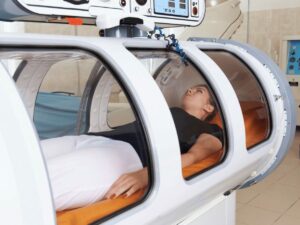Are you exploring innovative ways to enhance your mental health care offerings? Hyperbaric chambers could be what you’re searching for.
With extensive research and firsthand experience in hyperbaric technology, I offer insights grounded in the latest scientific findings and practical applications in healthcare settings.
Hyperbaric chambers for depression are gaining attention for their potential to improve mental health outcomes. This therapy offers a fascinating blend of traditional healing and modern technology.
In this guide, we’ll explore the science behind the hyperbaric chamber for depression, how it compares to conventional treatments, and practical considerations for healthcare facilities considering its implementation.
Read on for misery exploration!
1. The Science Behind Hyperbaric Chamber
Hyperbaric oxygen therapy (HBOT) is grounded in the principle of increasing atmospheric pressure to enhance the body’s oxygen absorption. Inside a hyperbaric chamber, patients breathe pure oxygen at pressures higher than the normal atmosphere. This process significantly boosts oxygen levels in the bloodstream, which can help heal tissues and organs.
Research has shown that this increase in oxygen can stimulate the release of growth factors and stem cells. But there’s a catch, these elements are crucial for repairing damaged brain tissues and promoting neuroplasticity. For individuals with depression, this could mean improved brain function and mood stabilization, offering a promising avenue for treatment.
2. How Hyperbaric Chamber Works for Depression
In treating depression, the hyperbaric chamber creates an environment where the air pressure is significantly higher than what we experience at sea level. This unique setting allows patients to inhale oxygen at a higher concentration. So what’s my point? Through this method, the body’s tissues receive more oxygen than under normal conditions, which is essential for the therapeutic process.
Inside the chamber, the elevated pressure and oxygen levels work together to enhance the body’s natural healing responses. For instance, in dealing with depression, this means encouraging the brain to regulate mood more effectively. The hyperbaric chamber offers a physical basis for therapy, aiming to improve mental health by directly influencing the body’s oxygen use and brain function.
3. Patient Experiences Inside Hyperbaric Chamber
Transitioning from understanding how hyperbaric chambers work for depression, we delve into what patients experience during their sessions. Here are the experiences reported:
Claustrophobia
The enclosed nature of the hyperbaric chamber can trigger claustrophobia in some patients. This reaction is understandable given the confined space and the door being sealed during treatment. As per an article in the National Library of Medicine, 8 per 10,000 treatments are reported to have claustrophobic patients. Facilities often guide to help patients manage these feelings, ensuring comfort throughout their sessions.
Comfort and Calm
As patients adjust to the pressure, a significant number express feeling unexpected comfort and calm. The environment, initially perceived as clinical, becomes a secluded retreat where the distractions of the outside world are muted. This sense of isolation can be therapeutic, providing a break from external stressors and contributing to mental well-being.
Breathing Deeply
The act of breathing in a hyperbaric chamber is described as more intentional and deep, given the pure oxygen environment. Patients often mention a heightened awareness of their breathing, which can have a soothing effect. This increased oxygen intake is crucial for the therapy’s aim but also serves to center the patient’s focus on their body and breath, enhancing relaxation.

4. Potential Side Effects of Hyperbaric Chamber for Depression
While patient experiences inside hyperbaric chambers often highlight the therapy’s benefits, it’s important to also consider the potential side effects. Here are some commonly reported effects by those undergoing treatment for depression:
Ear Discomfort
One of the immediate side effects can be ear discomfort or pain due to the rapid pressure changes inside the chamber. This sensation is similar to what one might experience during airplane takeoffs and landings. While usually temporary, it can be unsettling for new patients until they become accustomed to the process of equalizing ear pressure.
Sinus Pressure
Increased atmospheric pressure can also lead to sinus pressure or pain. This is because the sinuses, like the ears, need to adjust to the pressure differences. Now, this is important, patients with pre-existing sinus issues might find this particularly uncomfortable, though it’s generally a temporary discomfort.
Fatigue
Some individuals report feeling fatigued after their hyperbaric session. This side effect is interesting, considering many patients also report feeling revitalized. The contrast in experiences highlights how individual responses to the treatment can vary significantly.
Vision Changes
A less common but noted side effect is temporary vision changes, such as blurriness. These changes are typically mild and resolve on their own shortly after completing a series of treatments. That’s when I realized that patients are advised to monitor their vision and report significant alterations to their healthcare provider.

5. Comparing HBOT with Traditional Depression Treatments
Acknowledging the side effects of a hyperbaric chamber for depression, it’s crucial to compare HBOT with more traditional depression treatments. Here’s a detailed comparison:
HBOT vs. Psychotherapy
- HBOT: HBOT provides a physiological approach, enhancing oxygen delivery to the brain, which can indirectly support mood stabilization and cognitive functions.
- Psychotherapy: Psychotherapy offers a conversational approach, enabling patients to explore their emotions and behaviors with a therapist to identify and resolve issues.
HBOT vs. Cognitive Behavioral Therapy (CBT)
- HBOT: While HBOT doesn’t directly address thought patterns, improved brain function and mood stabilization may enhance a patient’s responsiveness to cognitive behavior.
- Cognitive Behavioral Therapy (CBT): CBT directly tackles negative thought patterns and behaviors, offering strategies to manage and overcome them, which is fundamental for long-term mental health management.
HBOT vs. Psychodynamic Therapy
- HBOT: HBOT’s role is supportive, potentially making the brain more receptive to undergoing therapy by improving overall brain health and emotional regulation.
- Psychodynamic Therapy: This therapy dives deep into exploring past experiences and unconscious processes, aiming to resolve them to treat depression, requiring active and sustained engagement from the patient.
6. Controversies Surrounding Hyperbaric Chamber for Depression
In the wake of comparing HBOT with traditional treatments for depression, it’s important to delve into the ongoing debates surrounding hyperbaric chambers treating depression. Here are the controversies discussed:
Scientific Analysis
The effectiveness of hyperbaric chambers in treating depression has come under scientific analysis. Critics often point to the need for more in-depth and extensive research to firmly establish its efficacy. The reliance on anecdotal evidence rather than peer-reviewed studies fuels this controversy, leaving room for doubt in the scientific community.
Accessibility Issues
The cost of hyperbaric chamber therapy poses significant accessibility issues. Its high price tag puts it out of reach for many, sparking debate over its feasibility as a treatment option. Additionally, the lack of insurance coverage due to insufficient evidence of effectiveness exacerbates these accessibility concerns, making it a less viable option for the average patient.
Patient Safety
Concerns about patient safety during hyperbaric therapy also contribute to the controversy. While side effects like ear discomfort and claustrophobia are generally considered mild, they raise questions about the therapy’s suitability for all patients, especially those with existing conditions that could be exacerbated by the chamber environment.
| Concern |
Description |
| Ear Discomfort |
Patients may experience discomfort or pain in the ears due to changes in pressure during hyperbaric therapy, which can range from mild to severe. |
| Claustrophobia |
Some individuals may experience feelings of anxiety or panic due to the confined space of the hyperbaric chamber, potentially leading to the discontinuation of therapy. |
| Suitability for All Patients |
There are concerns regarding the appropriateness of hyperbaric therapy for certain individuals, particularly those with pre-existing medical conditions that could be aggravated by the chamber environment. |
| Side Effects |
While generally considered mild, side effects such as oxygen toxicity, barotrauma, and vision changes can occur during hyperbaric therapy, necessitating careful patient monitoring and management. |
| Controversy |
The presence of these concerns contributes to the ongoing controversy surrounding the use of hyperbaric therapy, prompting discussions on its risk-benefit profile and appropriate patient selection criteria. |
7. 3 Tips for Considering Hyperbaric Chamber for Depression
Following the discussion on the various controversies, it becomes required for healthcare facilities to be sensitive in their choice of hyperbaric equipment. Here are the considerations to focus on:
#1 Chamber Type
Evaluate the type of hyperbaric chamber best suited for treating depression within your facility. For example, monoplace chambers are designed for a single patient and offer a controlled environment, which might be preferable for individualized treatment. Oxygen-ark’s multiplace chambers accommodate multiple patients, can foster a shared experience but require different operational considerations.
#2 Safety Features
Prioritize safety features in the chamber’s design, such as emergency shut-off systems, secure locking mechanisms, and reliable pressure controls. Oxygen-ark’s chambers have built-in communication systems for patients to easily contact staff outside the chamber if they feel uncomfortable or in case of an emergency.
#3 Oxygen Delivery
Examine the oxygen delivery system of the chamber. Some chambers provide 100% oxygen directly, while others increase the ambient pressure with air and then supply pure oxygen through a mask or hood. Here’s the interesting part, the method of oxygen delivery can impact the treatment’s effectiveness and patient comfort.
Conclusion
Exploring the potential of hyperbaric chambers for depression has unveiled a promising path for mental health treatment. This guide enlightens healthcare providers on the benefits, considerations, and practical applications of this innovative therapy.
For businesses eager to delve deeper into the therapeutic possibilities of hyperbaric chambers for depression, Oxygen-ark offers expert insights and solutions fitted to your needs. For a detailed discussion contact us today.


